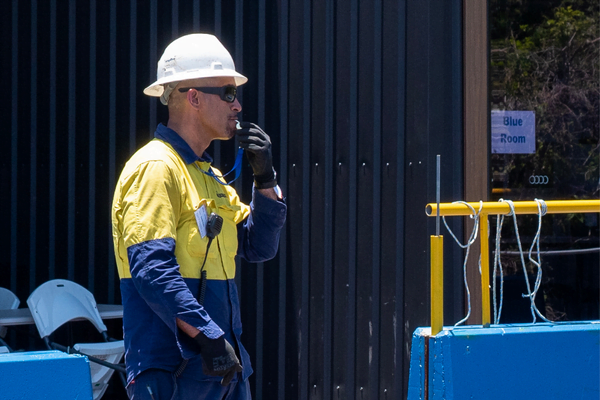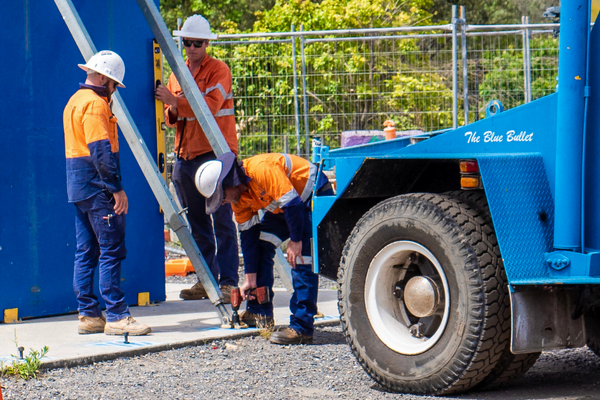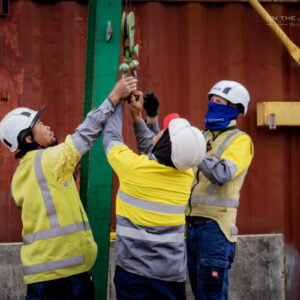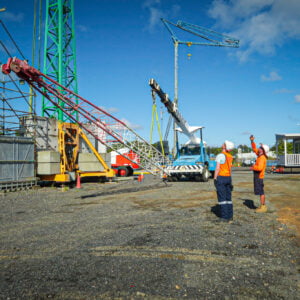DOGMAN TICKET COURSE (DG LICENCE)
Courses scheduled weekly, with a night course every 6 weeks Course CalendarOnline BookingUnit Name
CPCCLDG3001 – Licence to perform dogging
Licence
DG
Course Duration
5 Days
Entry Requirement/s
None
Course Cost*
Full price: $1595.00
CSQ funded price: $631.00
*Night courses incur $300 surcharge
This dogman ticket course leaves students better prepared for work
- Small groups, ensuring maximum time with trainers
- Up to 5 dogging stations means less waiting and more hands-on
- Online support resources including videos & podcasts
This dogging ticket course, over 5 days, is designed to ensure that participants have the skills and knowledge required to perform slinging techniques, including the selection and inspection of lifting gear and/or the directing of the crane operator in the movement of the load when the load is out of view of the crane operator for licensing purposes.
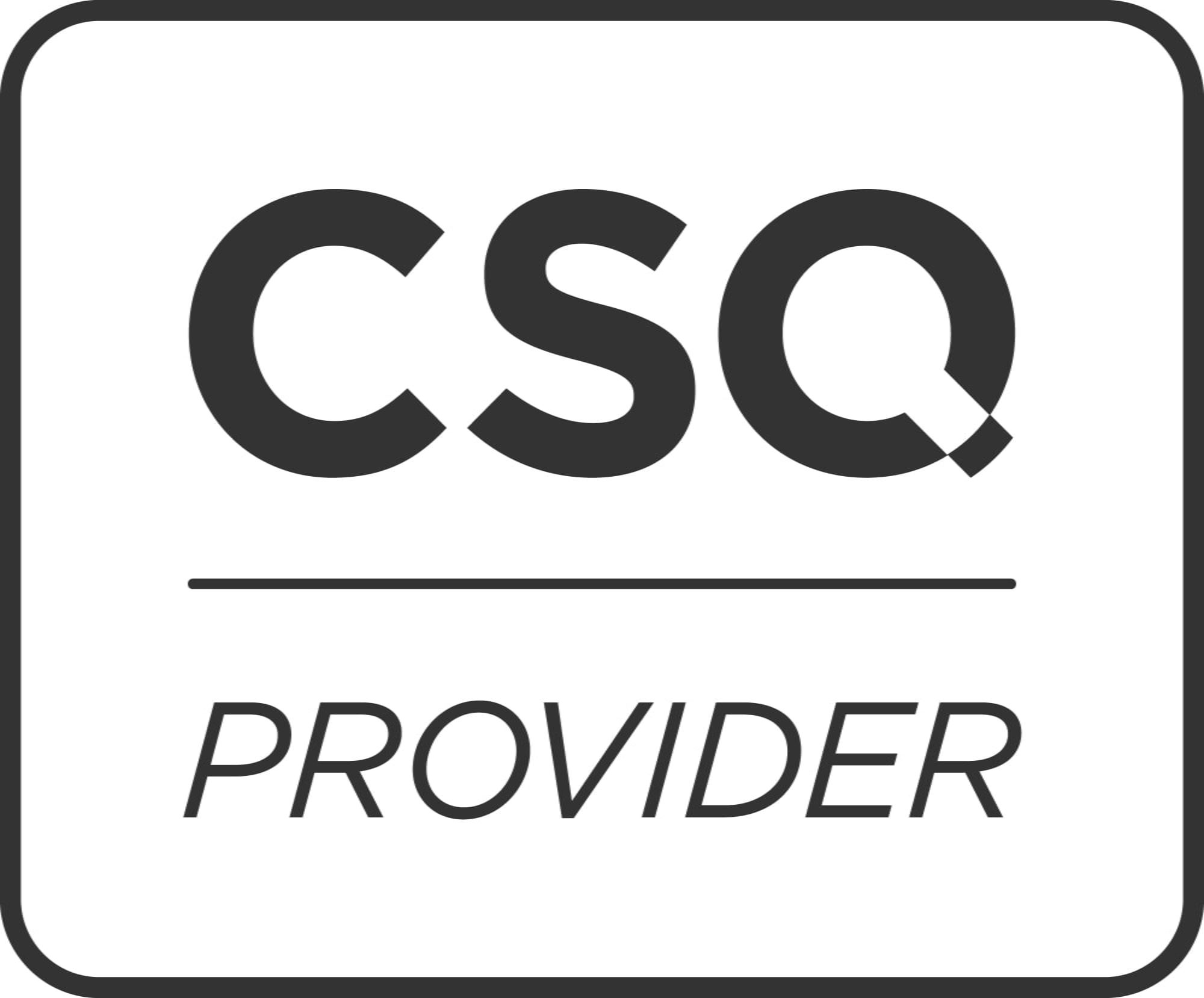

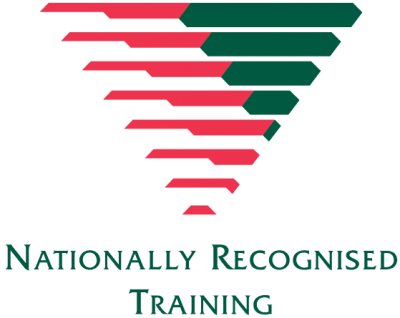
CPCCLDG3001 - Licence to Perform Dogging (DG Licence Outcome)
DOGMAN TICKET COURSE OVERVIEW:
This dogging course over 5 days, officially known by unit name 'Licence to Perform Dogging', is designed to ensure that participants have the skills and knowledge required to perform slinging techniques, including the selection and inspection of lifting gear and/or the directing of the crane operator in the movement of the load when the load is out of view of the crane operator for licensing purposes.
Dogging course participants will work with the Trainers and Assessors to develop their skills and knowledge, in small groups, ensuring maximum time with trainers. We operate up to three dogging stations at one time for less waiting around and more hands-on experience. We also give dogmen the opportunity to operate the mobile cranes to gain an understanding from an operator's point of view as they communicate with their dogger when conducting a lift.
This course option is suitable for participants without access to a workplace to gain experience, or workplaces who don’t have the resources to supervise staff while gaining nominal hours. If at any time during these 5 days the assessor recognises the need for the participant to complete gap training, participants will be given their logbook to gain nominal hours in the workplace prior to attending an assessment.
Watch some real examples of our Dogging Course training below.
On successful completion of this 'Licence to Perform Dogging' course, participants will be able to apply for a Dogging Licence (DG). There are costs associated with applying for the licence. Please visit www.worksafe.qld.gov.au for current licence fees.
DG LICENCE APPLICATION:
This unit specifies the skills and knowledge required to safely perform dogging work. Dogging consists of the application of slinging techniques to move a load, including the selection and inspection of lifting gear, and the directing of a plant operator in the movement of a load when the load is out of sight of the operator.
Dogging work is conducted in the construction industry and other industries where loads are lifted and moved using cranes or hoists.
Completion of the general construction induction training program, specified in the Safe Work Australia model Code of Practice: Construction Work, is required by anyone carrying out construction work. Achievement of 'CPCCWHS1001 - Prepare to work safely in the construction industry' (aka White Card) meets this requirement.
ELEMENTS & PERFORMANCE CRITERIA:
- Plan tasks: including reviewing task instructions, obtaining and interpreting information, identify workplace and task-specific hazards, calculating a load, determining lifting and slinging points, calculating working load limits and determining communication methods with the plant operator.
- Select and inspect equipment: Select and check risk controls and equipment, PPE, lifting equipment and gear and communication equipment.
- Setup a task: Establish and maintain communication, ensure risk controls, safety measures and equipment, prepare lifting equipment and gear for safe use, consult with relevant persons to ensure that the load destination is stable, able to bear the load and prepared for safe access and landing, attach and secure lifting equipment and gear to the plant-designated lifting point.
- Perform task: direct plant designated lifting point/hook, attach and secure lifting equipment and gear to the load, use signals and radio communication methods to direct the load movement, both in and out of sight of the plant operator and conduct a test lift. Direct the movement of the load in accordance with lift plan, including lowering and landing and disconnect lifting gear from the load and direct the positioning of crane or hoist for next task.
- Pack up job and clean up: Remove excess materials, inspect lifting equipment and gear for defects, store lifting equipment and gear in accordance with workplace requirements and remove risk controls and safety measures and equipment.
Full course outline details available at the Australian Government Training Website
LEARNING OUTCOMES:
- Communication techniques in the workplace including whistles, hand signals and use of fixed channel two-way radios
- Calculate rated capacity of lifting equipment
- Ability to interpret rated capacity and working load limit tags
- Hazard identification and control
- Slinging techniques
- Selection and inspection of lifting equipment
- Directing crane operators in the moving of loads in a safe manner, using a slewing crane
- Inspection and care of a wide range of lifting equipment to appropriate Australian Standards and/or manufacturer's specifications.
- Appropriate mathematical procedures for estimation and measurement of loads
- Basic knowledge of types of cranes and their functions
- WHS legislation, standards and codes of practice relevant to the full range of techniques for undertaking dogging activities
- Load stability and safety factors in line with manufacturer's specifications
- Understanding of the hierarchy of control
PRE-REQUISITES FOR THIS COURSE:
All participants are required to provide 100 Points of identification (as per Workplace Health and Safety Queensland requirements)
They will also need to have the ability to read, write & understand English. There are no pre-requisite licences or units of competencies to participate in this course.
LICENSING / REGULATORY INFORMATION:
Legislative and regulatory requirements are applicable to this unit of competency.
This unit is based on the licensing requirements of Part 4.5 of the Model Work Health and Safety (WHS) Regulations and meets Commonwealth, State and Territory HRWL requirements.
The National Assessment Instrument (NAI) is the mandated assessment for the HRWL to operate the relevant licencing class as detailed in this unit.
ADDITIONAL INFORMATION:
Course Timing:
Course days typically run from 6:30am to approximately 3:00pm - Participants are advised to arrive 15 minutes early to sign in. You may be required to start before 6:30am and stay after 3:30pm depending on how long the formal assessment runs for, we will advise of these times on the day of formal assessment. There are also night courses available which run 3.30pm - 9.30pm.
Course Structure:
Please note: Competence in a unit does not in itself result in a licence.
Once the trainer believes the participant has demonstrated theoretical and practical understanding of the chosen course (i.e ‘Unit of Competency’), this will be verified with a certificate or what’s known as a ‘Statement of Attainment’ from us, On the Job Training.
They then begin the process of obtaining a licence, via the relevant practical and theoretical assessments or ‘National Assessment Instruments’ (NAI). This is conducted by an assessor on behalf of Workplace Health & Safety Queensland (at On the Job Training). On successful completion of the mandated assessment, they will be issued with a ‘Candidate Assessment Summary’ (CAS) by On the Job Training.
Upon successful completion of the NAI as stated above, the Office of Industrial Relations Queensland will contact them with instructions on how to apply for the high risk work licence. For more information about costs associated with the chosen licence visit the Workplace Health & Safety website.
DOGMAN COURSE FEATURED CONTENT
Dogman Lifting Challenge
Why not check out some of our training videos to learn more or get a feel for what to expect with our training.
Tower Crane Dream: How a Bricklayer Became a Dogman
Sometimes you meet that special student, who you can immediately sense as a trainer that they are not only here to learn; they are metaphorically wearing their career goals on their sleeve. Read about Rhea’s inspiring story here.
6 Reasons you Need a Dogging Ticket
If you work in construction in Australia, chances are you’ve heard of a ‘Dogging ticket’. But what exactly is it? Why should you get one? How much can a dogger earn?
Dogging and Rigging : A Beginner’s Guide
If you’re looking to get into the construction industry, you may have heard the terms “dogging” and “rigging” being thrown around. But what do they mean? How do they differ?
TESTIMONIALS
Great experience, easy to understand and comprehend information being related by the trainer. Stress free learning and training environment. Would recommend to anyone seeking thier high risk work license. Shane and Bruce made the experience enjoyable and easy to get through.
I had an absolutely outstanding experience with the entire cew at OTJT.
Very professional and excellent range of experience and skills.
I can reccommend OTJT for having the ability of imparting a great deal of knowledge that will stay with me for the rest of my life. Well done team.
DogMAN Course FAQ’s
What is a dogman?
Dogmen work with crane operators and specialise in slinging loads. Doggers, as they’re also referred to, carry out tasks involving the lifting of items of varying weights, dimensions and materials with a crane.
What does a dogman do?
A Dogman’s duties include reading and interpreting lift plans; determining the safest routes for the lift, avoiding all obstructions along the way. They’re responsible for that load at all times with safety as their number one priority.
Doggers also select and maintain rigging equipment, as well as being constantly aware of their surroundings, both inside and outside the crane operating vicinity. In Australia, any decision that needs to be made in movement or slinging of a load with a crane, requires a qualified dogman with a dogman’s ticket. Aka a DG class high risk work licence.
How do you become a certified dogman?
To become a qualified Dogman or Dogger in Australia – you’ll need to undertake a Nationally Recognised Training ‘Licence to perform dogging – CPCCLDG3001’ course. Then, upon successful knowledge and performance licensing assessment of that course (using the national assessment instruments), you’ll be able to apply for a High Risk Work Licence (DG class).
This allows dogmen to safely direct crane operations with the necessary skills and knowledge.
How long does a dogging ticket course take?
The dogging ticket course, officially known as the ‘Licence to Perform Dogging’ unit of competency (unit code: CPCCDLG3001) is a 5 day course which leads to a licensed outcome (DG licence class).
How is the dogman ticket course structured?
Once the trainer deems you as competent in the unit, after demonstrating practical skills and producing a portfolio of theory based work, you will be issued with a certificate of successful completion – officially known as a Statement of Attainment.
You can then move onto the licensing assessment phase.
An accredited assessor, provided by On the Job Training (or relevant RTO if training not undertaken by us), will then assess you in order to be able to determine whether you can officially apply for a DG class high risk work licence (HRWL).
The relevant RTO will then contact the state workplace health and safety authority (e.g. Workplace Health & Safety Queensland, Safework NSW) who will then contact you directly inviting you to apply for a DG HRWL and will be issued by them
What assessments does the dogging ticket course include?
The ‘Licence to Perform Dogging – CPCCDLG3001’ unit assessment includes demonstrating practical tasks such as safely slinging and moving loads, inspecting lifting gear and effectively communicating with the crane operator.
It also includes a theoretical closed book exam that support these practical elements and a dogman’s responsibilities, as well as relevant maths calculations regarding determining the weight of a load and ensuring safe lifting of those loads based on various slinging configurations.
How much does a dogman's ticket course cost?
All registered training organisation’s (RTO’s) are free to set their own prices.
On the Job Training (RTO 70023), based in Stapylton between the Gold Coast and Brisbane, offer the ‘Licence to Perform Dogging – CPCCDLG3001’ unit for $1595. If you are eligible for CSQ Funding, then it’s $631. This includes training and assessment.
This does not cover the cost of the licence itself from the relevant health & safety authority. For a new HRWL application in Queensland (as of 3rd March 2023) the costs is $102.60, but checkout the Worksafe website for the current cost of licences.
How long is a DG high risk work licence valid for?
A DG licence, or any high risk work licence, is valid for 5 years. When you are close to this 5 year mark, your relevant safework/workplace health & safety authority will get in touch to invite you to renew.
If you exceed the expiration date by more than 1 year, you will need to undertake the relevant unit of competency again, if the unit of competency that you undertook has already been superseded. If it hasn’t been superseded, then you may be able to be reassessed.
It’s important that you keep your contact details up to date with the relevant authority to ensure you don’t miss your opportunity to renew without the hassle of redoing the units. We’ve had enquiries in the past whereby they’ve held several HRWL’s before but licence had expired by more than a year and had not choice but to do them again. This is both costly and time consuming, considering many HRWL courses can take 5 days and costs thousands of dollars.
Where is a DG licence valid?
A current DG licence, or any high risk work licence, obtained via completing a relevant unit of competency with successful assessment is valid anywhere in Australia, whether it’s issued by the relevant health & safety authority in Queensland, New South Wales or wherever.
It is possible to transfer your HRWL’s to another state, if for instance you undertook training if differing states. To do this, contact your relevant state safework/wokrplace health and safety authority on how to do this.
On the Job Training (RTO 70023) are one of the only RTO’s with a tower crane on their training yard in Australia, and the only one with 2. We often have students travelling to our base at Stapylton, Queensland to do the relevant courses to obtain CT or CS class licences, C0 open class slewing mobile crane licences and Advanced Rigging (RA).
Contact Us
Contact us any time using the details below. Alternatively, leave us a message using the enquiry form we will get back to you the following business day at the latest.
Phone: 07 3807 6061
Email: admin@onthejobtraining.edu.au
Address: 79 Christensen Road, Stapylton QLD 4207
Usual Business Hours: Mon - Fri 6.30AM - 5:00PM



